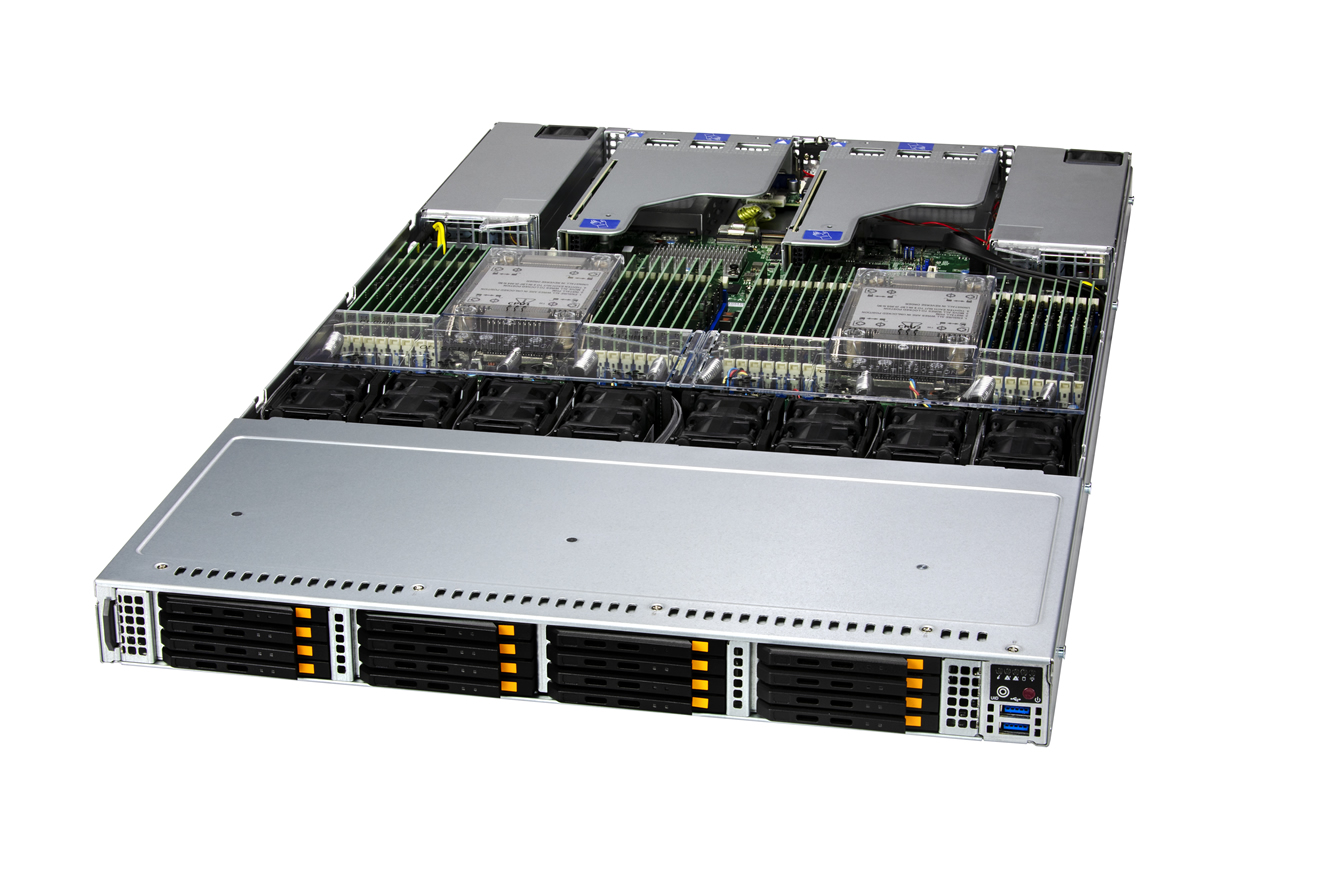Network Storage
Data Centres
Network Storage
News
Pure Storage and Micron expand collaboration
Pure Storage, an IT company that delivers advanced data storage technology and services, today announced the expansion of its strategic collaboration with Micron Technology, a global provider of memory and storage solutions. This collaboration enables the high-capacity and energy-efficient solutions that hyperscalers require using Micron G9 QLC NAND for future DirectFlash Module products.
The joint effort continues a decade-long initiative of integrating Micron’s latest NAND technology with Pure Storage products, which spans seven generations and includes the Micron G8 QLC NAND qualified for production in Pure Storage’s 150TB DirectFlash Module. Combined with Pure Storage’s advanced data storage platform, the solution delivers a data storage offering with massive drive capacities, high performance, and low latency - while driving architectural simplification and delivering significant energy efficiency improvements.
In modern data centres, three critical concerns factor into every storage system - energy efficiency, storage density, and performance. Data centres consume tremendous amounts of power, which is why energy-efficient solutions are critical to managing both operational expenses and the impact on the environment. Additionally, as data centres grow, they remain space-constrained, making every square foot valuable. Operators are continuously challenged to fit more storage into less space. Meanwhile, storage performance is even more important as a competitive advantage because consumers of data centre services expect faster data processing, as the rush to turn data into insights accelerates.
Pure Storage and Micron are collaborating to deliver a winning total cost of ownership option versus legacy hard drive-based storage offerings for hyperscalers. The collaboration provides the following benefits:
• Improved performance, lower latency: The combination of Pure Storage’s data storage platform with Micron’s advanced NAND technology with strong transfer rates provides ultrafast, low-latency, and reliable services for massive, data-intensive workloads.• Sustainability: This joint solution dramatically reduces the energy consumption over traditional storage options, lowering operating costs and reducing the environmental footprint.• Rack-dense, scalable options: By integrating Micron’s NAND that offers areal density (bits per square millimetre), Pure Storage can deliver highly scalable systems at a reduced total cost of acquisition and ownership.“Pure Storage’s collaboration with Micron is another example of our significant momentum bringing the benefits of all-flash storage technology to hyperscale environments,” says Bill Cerreta, General Manager, Hyperscale, Pure Storage. “With Micron’s advanced NAND technology, Pure Storage can further optimise storage scalability, performance, and energy efficiency for an industry with unparalleled requirements.”
“Micron’s advanced NAND technologies, combined with Pure’s innovative storage solutions, enable data centre operators to address the increasing performance, efficiency, and scalability needs for today’s hyperscale data centres,” adds Jeremy Werner, SVP & GM, Storage Business Unit, Micron. “Built on trust and thriving on innovation, our collaboration with Pure Storage consistently offers cutting-edge storage solutions for hyperscale and enterprise environments.”
For more from Pure Storage, click here.
Simon Rowley - 7 January 2025
Data
Network Storage
News
Product
Supermicro announces new E3.S all-flash storage solutions
Supermicro has announced that it is delivering a high throughput, low latency E3.S storage solutions, supporting the industry's first PCIe gen5 drives and CXL modules to meet the demands of large AI Training and HPC clusters, where massive amounts of unstructured data must be delivered to the GPUs and CPUs to achieve faster results.
Supermicro's petascale systems are a new class of storage servers supporting the latest industry standard E3.S (7.5mm) gen5 NVMe drives, from leading storage vendors for up to 256TB of high throughput, low latency storage in 1U or up to a half PB in 2U. Its innovative symmetrical architecture reduced latency by ensuring the shortest signal paths for data and maximised airflow over critical components, allowing them to run at optimal speeds. With these new systems, a standard rack can now hold over 20PB of capacity for high throughput NVMe-oF (NVMe over Fabrics) configurations, ensuring that GPUs remain saturated with data. Systems are available with either the 4th gen Intel Xeon Scalable processors or 4th gen AMD EPYC processors.
The systems also support up to 4xE3.S 2T (15 mm) CMM devices on Intel and AMD based platforms. These systems now enable memory cache coherency between CPU memory and PCIe attached DDR based memory devices. The new line-up of optimised storage systems includes 1U servers, supporting up to 16 hot-swap E3.S drives, or eight E3.S drives, plus four E3.S 2T 16.8mm bays for CMM and other emerging modular devices. The 2U servers support up to 32 hot-swap E3.S drives with both single-processor and dual-processor models. The dual-processor models support the latest 4th gen Intel Xeon Scalable processors, while the single-processor models support the latest 4th gen AMD EPYC processors.
Customers will experience increased performance with these latest technologies. These systems all include PCIe 5.0 (twice the performance of PCIe 4.0), 1.5X memory performance of DDR5 compared to DDR4, and up to 1PB in a compact 2U server when 30TB drives become available later this year.
Click here for latest data centre news.
Isha Jain - 14 August 2023
Data Centres
Network Storage
Networking
News
Product
Western Digital's new storage solutions for data centre architecture
From the cloud, to the edge, to the enterprise, data centre architects are deploying higher levels of flash to unlock the potential of AI, object storage, file sharing and more. At the same time, they are laser focused on controlling spend and must find solutions to help them manage, scale and utilise storage assets more efficiently.
This is driving a growing trend to disaggregate and share NVMe flash over fabric (NVMe-oF) for improved performance, availability and flexibility of storage resources. Helping customers simplify NVMe/NVMe-oF storage deployment, Western Digital has announced new solutions:
Enhanced OpenFlex Data24 3200 NVMe-oF JBOF/Storage Platform
Next generation RapidFlex A2000 and C2000 NVMe-oF fabric bridge devices (FBDs
New Ultrastar DC SN655 PCIe Gen 4.0 dual-port NVMe SSD
These new storage solutions are enabling an ecosystem, providing more flexibility and choice for simplifying solutions deployment for customers. It has vertical integration capabilities targeting both ends of the ethernet wire to deliver solutions, where data travels from the server initiator to the storage target.
Fully integrated OpenFlex Data24 3200 NVMe-oF Storage Platform
The platform extends the performance of NVMe flash to a shared storage architecture. By separating storage resources from compute, and sharing it over ethernet, OpenFlex Data24 becomes widely available to multiple applications and servers, allowing for greater resource control and scalability, leading to improved storage utilisation without overprovisioning.
Using RapidFlex FBDs, the Data24 3200 allows up to six hosts to be attached without a switch. A switched environment allows scaling even more hosts and Data24 platforms, providing scale-out or scale-up capabilities from hundreds of terabytes to petabytes of its flash with very low application latency. In addition to RDMA over converged Ethernet (RoCE), it now features new TCP connection support. Available in a 2U 24-bay platform and backed with a five-year limited warranty, it is built to deliver low power, high availability and enterprise-class reliability with up to 368TB in a single platform of low latency dual-port PCIe Gen 4.0 SSDs.
Next generation RapidFlex FBDs: the A2000 ASIC and the C2000 fabric bridge PCIe adapter card
The RapidFlex family of NVMe over fabric bridge devices provide the foundational building blocks for OEMs/ODMs and large organisations taking a DIY approach to their software-defined infrastructure to enable next generation workloads based on highly scalable shared storage across an ethernet fabric. These second generation low-power, high-performance FBDs come in two versions: the RapidFlex A2000 controller, and the RapidFlex C2000 that places the A2000 chip on a PCI adapter for powering solutions.
The new FBD is a unique state machine that exports the PCI bus over ethernet, allowing externally connected SSDs to appear as if they were local to the server. The new family also doubles performance with an additional 100GbE port matched to 16 lanes of PCIe Gen 4.0, and provides a PCIe root complex within all NVMe all-flash arrays, making it easy to qualify and deploy. The new FBDs add initiator mode capability to the existing target mode capability, so customers can now deploy more cost-effective and lower power initiator cards in their servers instead of a conventional ethernet NIC for NVMe-oF connectivity.
Enterprise-class Ultrastar DC SN655 Dual-Port NVMe SSD
This is a cost-effective, dual port, high capacity PCIe Gen 4.0 NVMe SSD designed for cloud, OEM and enterprise customers who need high-performance, high capacity storage for a variety of applications and workloads such as disaggregated storage, object storage, storage servers and other mission-critical applications.
The Ultrastar DC SN655 is a vertically integrated SSD that provides a simple, scalable, single-port or dual-port path to ensure continuous data access for enterprise high availability requirements. It also expands capacities from new 3.84TB to 15.36TB, targeting both storage and mixed workload compute applications, and increases drive reliability to 2.5 million hours mean time between failures (projected). Additionally, it reaches more than one million maximum random read IOPs and enhanced Qos for large unstructured workloads. It comes in a drop-in U.3 15mm form factor and is U.2 backwards compatible. It also offers additional enterprise features like power-fail protection and end-to-end data path protection to ensure data is available when needed.
Click here for latest data centre news.
Isha Jain - 9 August 2023
Data Centres
Network Storage
News
KIOXIA introduces new data centre class SSDs
KIOXIA has announced the addition of the KIOXIA CD8P Series to its line-up of data centre class solid state drives (SSDs).
The new series is well-suited to general purpose server and cloud environments that can take advantage of PCIe 5.0 (32GT/s x4) performance. Data centre applications can generate complex mixed workloads spread across large-scale virtualised systems in 24x7 operational data centres. The new drives are available in capacities up to 30.72TB and in both EDSFF E3.S and 2.5inch (U.2) form factors.
Optimised for performance, latency, reduced power and thermal requirements for data centre environments, where power and cooling efficiency is critical, the new series provides the predictability and consistency needed for a seamless user experience.
The KIOXIA CD8P Series realises approximately a 60% to 80% increase in sequential read performance, when compared to previous generation PCIe 4.0 SSDs, including:
Random read performance up to 2,000K IOPS and random write performance up to 400K IOPS.
Low and consistent 99.999th percentile latency of under 250us in standard random read workloads, and under 1.8ms in standard OLTP-style mixed workloads.
Single-port design, optimised for data centre class workloads.
The new data centre drives are based on the KIOXIA BiCS FLASH fifth generation, three-dimensional flash memory TLC technology, and utilise an inhouse developed controller. Its SSDs are compliant with PCIe 5.0 and NVMe 2.0 specifications, as well as the NVMe Express Management Interface (NVMe-MI) v1.1d, and support OCP data centre NVMe SSD specifications (not all requirements).
Additional features and benefits include:
Full data reliability with end-to-end data protection, power loss protection and flash die failure recovery.
Security options: Non-SED, SIE and SED (TCG Opal and Ruby SSCs).
Click here for latest data centre news.
Isha Jain - 8 August 2023
Cooling
Cooling
Data
Data Centres
Network Storage
Uncategorised
Paying attention to data centre storage cooling
Authored by Neil Edmunds, Director of Innovation, Iceotope
With constant streams of data emerging from the IoT, video, AI and more, it is no surprise we are expected to generate 463EB of data each day by 2025. How we access and interact with data is constantly changing and is going to have a real impact on the processing and storage of that data. In just a few years, it's predicted that global data storage will exceed 200ZB with half of that stored in the cloud.
This presents a unique challenge for hyperscale data centres and their storage infrastructure. According to Seagate, cloud data centres choose mass capacity hard disk drives (HDDs) to store 90% of their exabytes. HDDs are tried and tested technology, typically found in a 3.5in form factor. They continue to offer data centre operators cost effective storage at scale. The current top-of-the-range HDD features 20TB capacity. By the end of the decade that is expected to reach 120TB+, all within the existing 3.5in form factor.
The practical implications of this show a need for improved thermal cooling solutions. More data storage means more spinning of the disks, higher speed motors, more actuators – all of which translates to more power being used. As disks go up in power, so does the amount of heat produced by them. Next, with the introduction of helium into the hard drives in the last decade, performance has not only improved, thanks to less drag on the disks, but the units are now sealed.
There is also ESG compliance to consider. With data centres consuming 1% of global electricity demand and cooling power accounting for more than 35% of a data centre’s total energy consumption, pressure is on data centre owners to reduce this consumption.
Comparison of cooling technologies
Traditionally, data centre environments use air cooling technology. The primary way of removing heat with air cooling methods is by pulling increasing volumes of airflow through the chassis of the equipment. Typically, there is a hot aisle behind the racks and a cold aisle configuration in front of the racks which dissipates the heat by exchanging warm air with cooler air. Air cooling is widely deployed and well understood. It is also well engrained into nearly every data centre around the world. However, as the volume of data evolves, it is becoming increasingly likely that air cooling will no longer be able to ensure an appropriate operating environment for energy dense IT equipment.
Technologies like liquid cooling are proving to be a much more efficient way to remove heat from IT equipment. Precision liquid cooling, for example, circulates small volumes of dielectric fluid across the surface of the server, removing almost 100% of the heat generated by the electronic components. There are no performance throttling hotspots and no front to back air cooling, or bottom to top immersion constraints which are present in tank solutions. While initial applications of precision liquid cooling have been in a sealed chassis for cooling server components, given the increased power demands of HDD, storage devices are also an ideal application.
High density storage demands
With high density HDD, traditional air cooling pulls air through the system from front to back. What typically occurs in this environment is that disks in the front become much cooler than those in the back. As the cold air comes and travels through the JBOD device, the air gets hotter. This can result in a 20°C or more temperature differential between the discs at the front and back of the unit depending on the capacity of the hard drive.
For any data centre operator, consistency is key. When disks are varying by nearly 20°C from front to back, there is inconsistent wear and tear on the drives leading to unpredictable failure. The same goes for variance across the height of the rack, as lower devices tend to consume the cooler air flow coming up from the floor tiles.
Liquid cooling for storage
While there will always be variances and different tolerances taking place within any data centre environment, liquid cooling can mitigate for these variances and improve consistency. In 2022, Meta published a study showcasing how an air cooled, high density storage system was reengineered to utilise single phase liquid cooling. The study found that precision liquid cooling was a more efficient means of cooling the HDD racks with the following results:
The variance in temperature of all HDDs was just 3°C, regardless of location inside the JBODs.
HDD systems could operate reliably in rack water inlet temperatures up to 40°C.
System-level cooling power was less than 5% of the total power consumption.
Mitigating acoustic vibrational issues.
While consistency is a key benefit, cooling all disks at a higher water temperature is important too. This means data centre operators do not need to provide chilled water to the unit. Reduced resource consumption – electrical, water, space, audible noise – all lead to greater reduction in TCO and improved ESG compliance. Both of which are key benefits for today’s data centre operators.
As demand for data storage continues to escalate, so will the solutions needed by hyperscale data centre providers to efficiently cool the equipment. Liquid cooling for high density storage is proving to be a viable alternative as it cools the drives at a more consistent temperature and removes vibration from fans, with lower overall end-to-end power consumption and improved ESG compliance. At a time when data centre operators are under increasing pressure to reduce energy consumption and improve sustainability metrics, this technology may not only be good for the planet, but also good for business.
Enabling innovation in storage systems
Today’s HDDs are designed with forced air cooling in mind, so it stands to reason that air cooling will continue to play a role in the short term. For storage manufacturers to embrace new alternatives demonstrations of liquid cooling technology, like the one Meta conducted, are key to ensuring adoption. Looking at technology trends moving forward, constantly increasing fan power on a rack will not be a long term sustainable solution.
Data halls are not getting any larger and costs to cool a rack are increasing. The need for more data storage capacity at greater density is exponentially growing. Storage designed for precision liquid cooling will be smaller, use fewer precious materials and components, perform faster and fail less often. The ability to deliver a more cost effective HDD storage solution in the same cubic footprint, delivers not only a TCO benefit but contributes to greater ESG value as well. Making today's technology more efficient and removing limiting factors for new and game changing data storage methods can help us meet the global challenges we face and is a step forward towards enabling a better future.
Click here for more thought leadership.
Isha Jain - 25 July 2023
Cloud
Network Storage
Networking
Infinidat named finalist for Tech Innovator Awards
Infinidat has announced that CRN, a brand of The Channel Company, has named Infinidat as a finalist for the 2023 CRN Tech Innovator Awards. It is being recognised for its InfiniBox solution in the ‘Storage−Enterprise’ category.
The InfiniBox solutions portfolio offers two major choices: the InfiniBox SSA II solid-state storage array and the InfiniBox hybrid storage array.
For enterprises that require consistent sub-millisecond latency for every I/O, it provides the InfiniBox SSA II, which is the industry’s fastest all-flash storage array with latency as low as 35 microseconds, driving unsurpassed real world application performance. The InfiniBox hybrid system combines DRAM, flash caching layers, and high capacity, cost effective HDDs, optimised by its patented Neural Cache technology. The use of HDDs dramatically lowers the cost of storage, while delivering 100% guaranteed availability, powerful cyber storage resilience and ease of use with its autonomous automation.
“With its cyber storage capabilities, InfiniBox is one of the most exciting enterprise storage solutions on the market today, addressing one of the critical concerns of Fortune 500 CEOs − cyber security. Congratulations to Infinidat for repeatedly receiving industry awards for their technological innovation and the business value they bring to our enterprise customers. As a trusted partner, Infinidat continues to provide a powerful storage solution for enterprises who need to get the most out of their storage investment,” says Bob Elliott, Vice President, Storage at Mainline Information Systems.
This annual award program showcases innovative vendors in the IT channel across 37 different technology categories, in key areas ranging from cloud to storage to networking to security. To determine the 2023 winners, a panel of CRN editors reviewed hundreds of vendor entries − including solution provider testimonials − using multiple criteria, including key capabilities, uniqueness, technological ingenuity and ability to address customer and partner needs.
The Tech Innovator Awards will be featured in the August issue of CRN and can be viewed online at crn.com/techinnovators.
Isha Jain - 21 July 2023
Cloud
Data
Internet
Network Storage
Networking
News
Aruba launches unlimited storage services
As the digital world grows at an increasing pace, more and more space is needed to store one’s data. For this reason, the web is teeming with articles offering useful tips for saving space, emptying one's inbox of excessively heavy content and tricks on how to free up precious GBs of memory. As of today, one less thought will be required.
Aruba has announced the availability of the new unlimited email storage service which will ensure that owners of Aruba email account will no longer have to worry about freeing up space or increasing the capacity of their account, as they will be able to store all their emails with unlimited storage.
The company provides its users with a definitive solution to a need that is destined to grow over time. As well as enabling unlimited email storage, it has also made the Aruba Drive application available, which offers an unlimited cloud space where users can store their files, protect them and ensure easy access and sharing capabilities. With the drive, it is possible to store and share numerous types of files, relying not only on unlimited space, but also on a proprietary space relating to one’s own domain name. Once an account has been created and files have been uploaded to the online space, users can view them, share them with whoever they wish and edit them using various tools. It is integrated for working on text documents, spreadsheets and presentations, or for retouching photos and organising photos and videos in albums.
SpazioMail Unlimited and Aruba Drive add to the offer of unlimited web space and traffic already present in the Aruba hosting offer, effectively creating an ecosystem of services that revolves around a wide range of quality hosting solutions.
Details about unlimited email storage
The service costs €14.99 + VAT/year. Until 2 August 2023, users can register or transfer a domain with email by purchasing unlimited email storage for only €1.99 + VAT for the first year, upon renewal from €30.48 + VAT.
Aruba Drive is available in three different plans:
Aruba Drive Easy- for storing and digitising files with no space limits and easy access. Includes a user account, unlimited space, domain registration and five email accounts. Costs from €50.00 + VAT/year.
Aruba Drive Advanced- provides a storage space that is synchronised with desktop and mobile applications and integrated with working tools to optimise efficiency in daily activities. Includes a user account, unlimited space, domain registration and five email accounts, integrated tools and synchronisation with apps. Costs from €100.00 + VAT/year.
Aruba Drive Professional- the most comprehensive solution, ideal for team and company work. Includes ten usernames, unlimited space, domain registration and five email accounts, integrated tools and synchronisation with apps. Costs from €300.00 + VAT/year.
In addition, a promotion is available until 20 December 2023 with a 50% discount for the first year on all plans.
Click here for more on Aruba.
Isha Jain - 20 July 2023
Data Centres
Disaster Recovery
Network Storage
News
Security
BlueHat Cyber improves data centres with Tintri solutions
Tintri has announced that BlueHat Cyber has implemented Tintri’s VMstore solutions as the backbone of its Infrastructure as a Service (IaaS) and Disaster Recovery as a Service (DRaaS) business. Its technology allows BlueHat Cyber to offload time-consuming administrative storage tasks and replicate across data centres, so it can focus on providing its clients with premium service.
BlueHat Cyber offers a cyber security portfolio and assists in planning, design, integration, operation, and optimisation of organisations’ IT security requirements. It needed a solution to simplify storage management, improve I/O and replicate workloads across multiple data centres, and chose Tintri VMstore as the solution for its benefits with fast asynchronous replication, increased uptime and performance, and ‘set it and forget it’ operations.
Now, BlueHat Cyber’s US Virtual Data Centre is running on 100% Tintri VM-aware technology because it is a purpose-built solution to store and manage virtualised workloads in enterprise data centres.
“We went from spending eight to 10 hours a week managing storage to maybe taking a glance at it once in a blue moon. We basically set it and forget it. When looking at a new client proposal, we consider if we have the capacity to take it on, but we never have to think about I/O performance, regardless of how intense the workload,” says Tim Averill, CTO, BlueHat Cyber.
“The key to a simple and successful hybrid cloud deployment is the use of best-of-breed technologies and industry best practices along with the support from an experienced MSP partner who can make the most cost-effective and future-proof recommendations, allowing your infrastructure to grow with your business,” says Brock Mowry, CTO, Tintri. “We are proud to see Tintri VMstore deliver on simplified and worry-free data management as it has proven to do for BlueHat Cyber.”
Isha Jain - 16 June 2023
Data
Network Storage
News
Spectra Logic and Titan partner to expand EMEA market footprint
Spectra Logic has announced that it has partnered with Titan to expand the EMEA market footprint with innovative data management solutions. The relationship, which spans the EMEA region, will leverage Titan’s knowledge of the data management industry to further broaden Spectra’s reseller base.
Craig Bungay, Vice President, Sales for EMEA at Spectra, comments, "There is perfect synergy between Spectra and Titan – we’re both committed to providing solutions that address key customer challenges. Spectra’s approach to on-prem Glacier and digital archiving requires the skill and market knowledge that a partner like Titan brings in order to meet the demand for our data management portfolio."
This partnership will see Titan distribute the entire Spectra product portfolio, including object storage and NAS with the BlackPearl platform, StorCycle enterprise software for digital archive, and the company’s full range of tape libraries to its resellers, targeting horizontal and vertical markets such as media and entertainment, life sciences, and HPC.
Both companies see a number of benefits in this new partnership, mainly because Spectra helps customers in many different industries optimise their storage infrastructures with data management and storage solutions.
David Treadwell, Solutions Director at Titan, says, “With a strong focus on data management, Spectra Logic will help our resellers’ end users manage, store, and preserve data long-term, whether on-prem or within multi-cloud environments. While perhaps best-known historically for tape, Spectra’s solution portfolio has expanded significantly over the past 10 years, and its core value stems from its software stack that enables customers to better manage and protect their data.”
Through its broad technology range, Spectra will help Titan’s customer base at every stage of the data lifecycle, with solutions around hybrid cloud, object storage, data management software, S3 and NAS storage, tape libraries, and of course a complete digital archive solution.
Isha Jain - 15 June 2023
Network Storage
NetApp delivers future-proof storage investment option
Technology renewals and disruption are causing major headaches for CIOs who are unsure where to place their operating budgets. This is, according to Westcon-Comstor, particularly problematic when it comes to storage infrastructure purchases, but it’s a problem it feels customers can address with NetApp Advance.
“Infrastructure modernisation is a term used in almost every conversation. But the bottom line is that it can't be viewed as an option. It is a necessity,” says Daniel Thenga, NetApp and SolarWinds Architecture Manager and Business Unit Manager, Comstor Southern Africa. “Market disruption is a huge problem for customers navigating inflation, budget cuts, limited CapEx, skills shortages, and sustainability mandates. This makes it even more difficult for a business to future-proof their tech investments, of which storage remains a key part.”
Working with NetApp, Westcon-Comstor assists partners in guiding customer decisions around solutions that offer clients the right performance, at the right price, with the lowest carbon footprint, and that can scale regardless of the future, which is where the distributor suggests using NetApp Advance.
NetApp Advance is a portfolio of programs and guarantees that go hand-in-hand with the vendor’s NetApp AFF and FAS systems, including its new capacity flash AFF C-Series. The Storage Lifecycle Program (SLP) is central to this offering, following a 'buy once and get IT technology that evolves with you’ model. The program centres on:
More accessible, more straightforward, and faster upgrade cycles when purchasing a NetApp AFF or FAS system with the SLP option. The solutions are upgradeable indefinitely with non-disruptive refreshes of storage controllers every three years at no additional cost.
Trade-in capacity that limits investment risk and will future-proof storage purchases when acquiring additional capacity and trading in existing SLP-covered storage media for a 100% capacity credit.
VIP services and AI-powered analytics provide insights into the performance of storage systems through proactive monitoring, full-stack visibility, and actionable insights.
A simplified software experience through continual software updates and access to new ONTAP capabilities and advancements as soon as they become available.
“With NetApp Advance, NetApp has also factored in that most clients will undergo some form of cloud journey if they aren't already. This is supported through its Cloud Advantage program, which allows a customer to swap an on-premises controller refresh for cloud services or hybrid cloud storage as a service with NetApp Keystone. This is optionality never really seen before, as your purchase follows your plans without creating a legacy problem,” adds Daniel.
Within the NetApp Advance program, there is also a storage efficiency guarantee. NetApp offers a guaranteed storage efficiency of 4:1 for SAN workloads and 1.5:1 for NAS workloads on its ONTAP AFF systems. This is essential for African businesses looking to improve energy usage, and reduce energy costs while trying to become more sustainable.
Right-sizing and tiering are also simplified as users can automate the movement of infrequently used data to more cost-efficient object storage without refactoring applications. NetApp’s storage is also natively available on AWS, Microsoft Azure and Google Cloud, allowing clients to tier to a cloud of choice or from high-performance all-flash to hybrid-flash/HDD systems.
“NetApp Advance is not a crystal ball, but it’s a bold move by a company in recognising the challenges facing CIOs when needing to upgrade or refresh technology, or even when they need to pivot their tech model to a more modernised approach,” concludes Daniel.
Beatrice - 22 May 2023

Head office & Accounts:
Suite 14, 6-8 Revenge Road, Lordswood
Kent ME5 8UD
T: +44 (0)1634 673163
F: +44 (0)1634 673173









